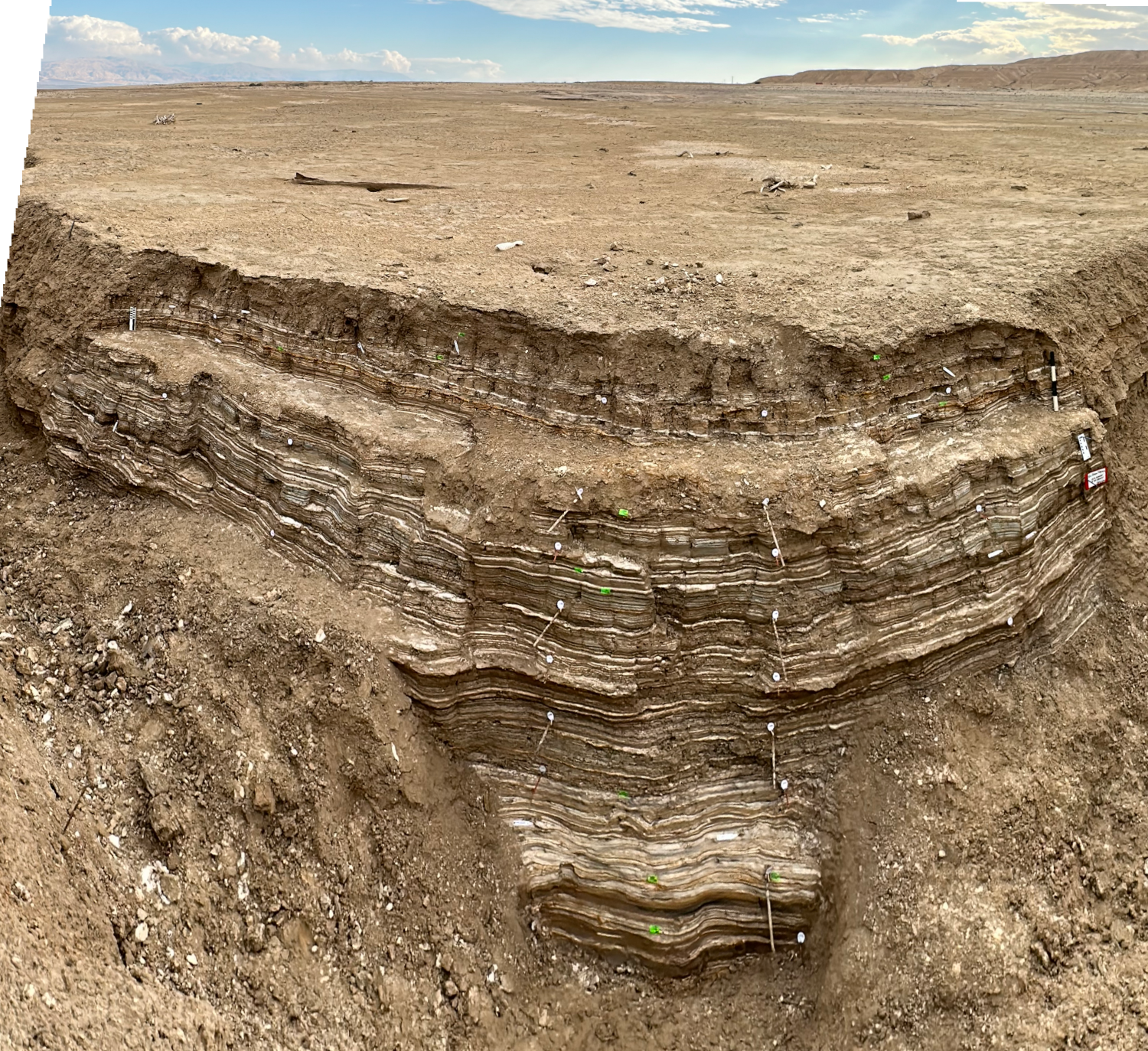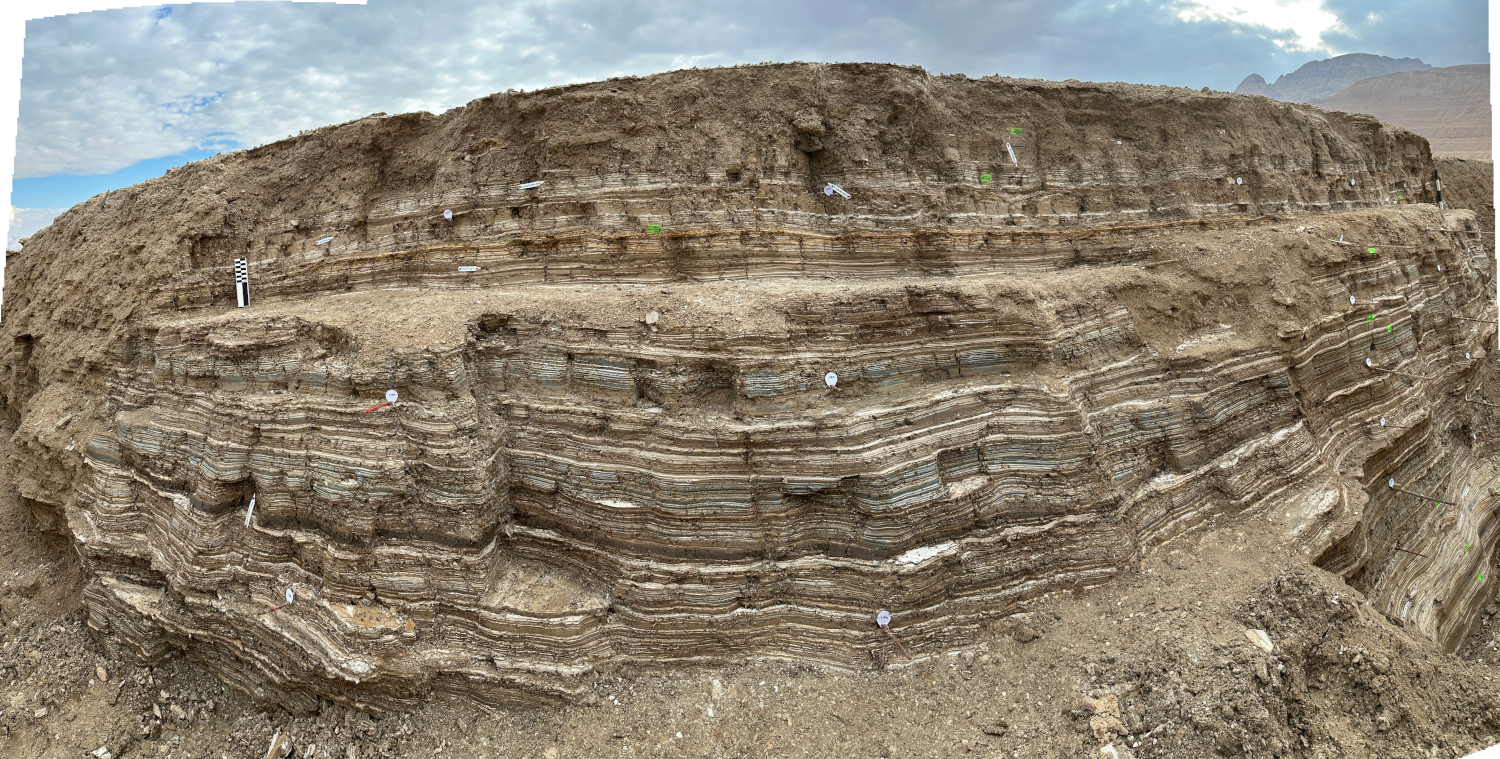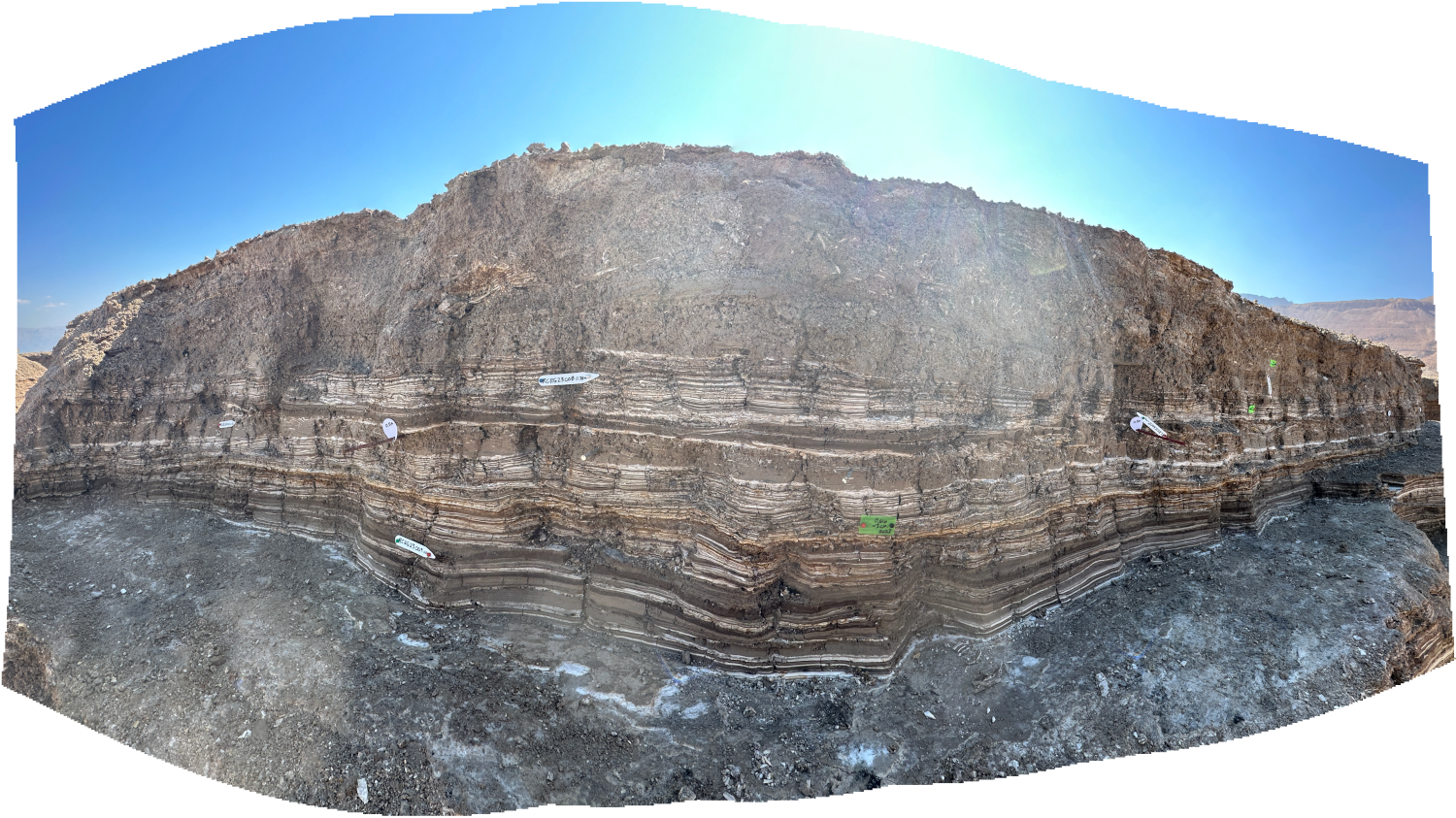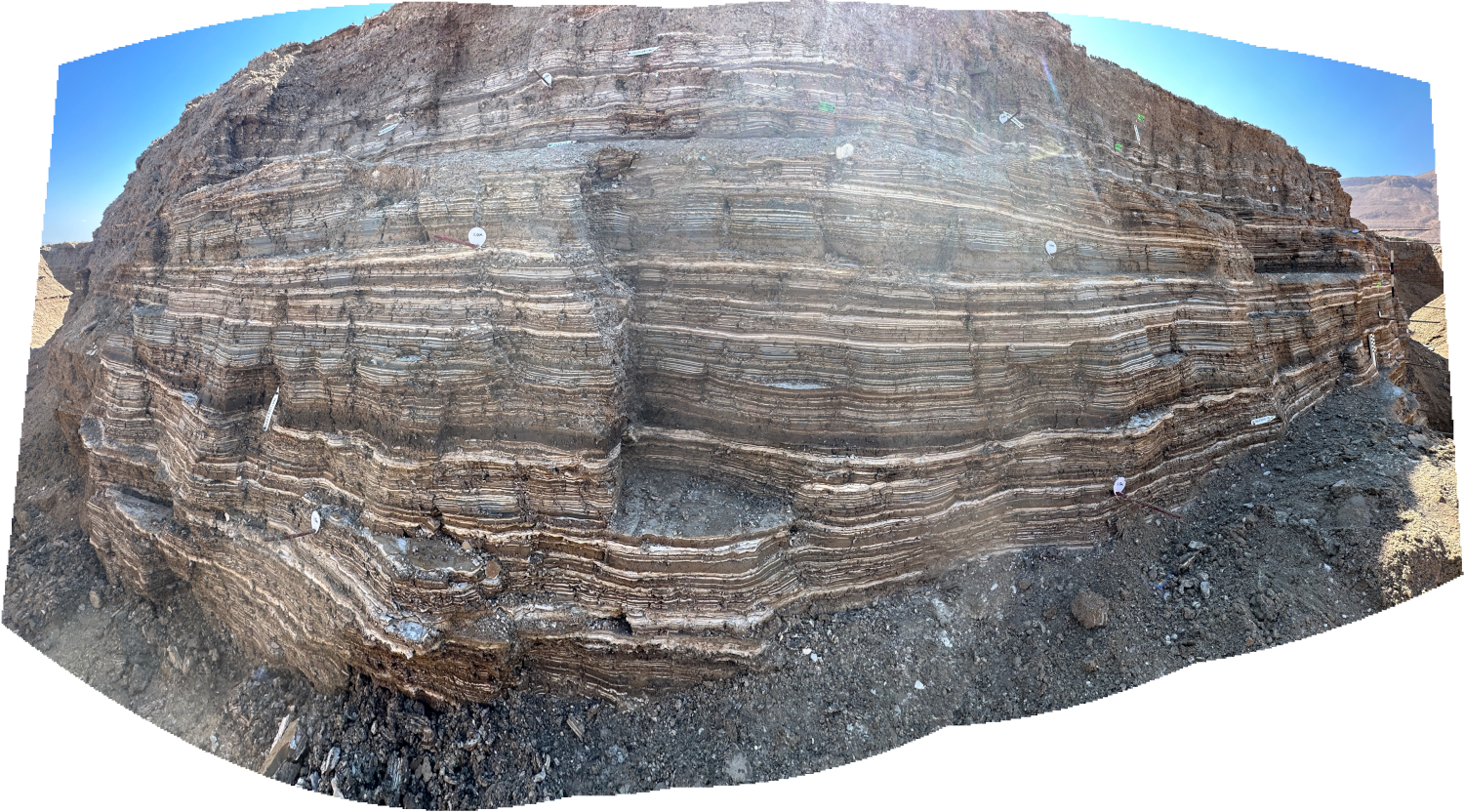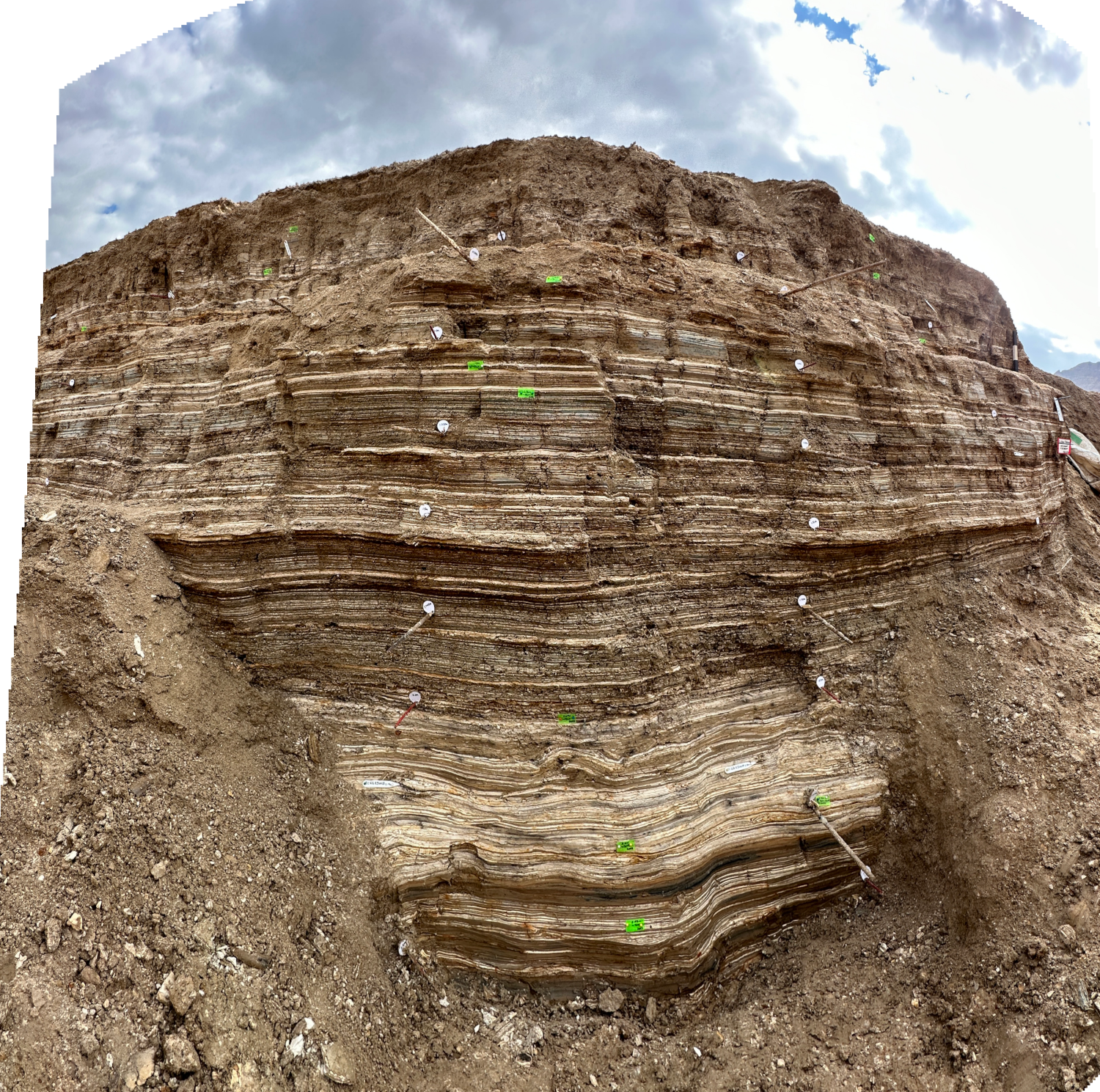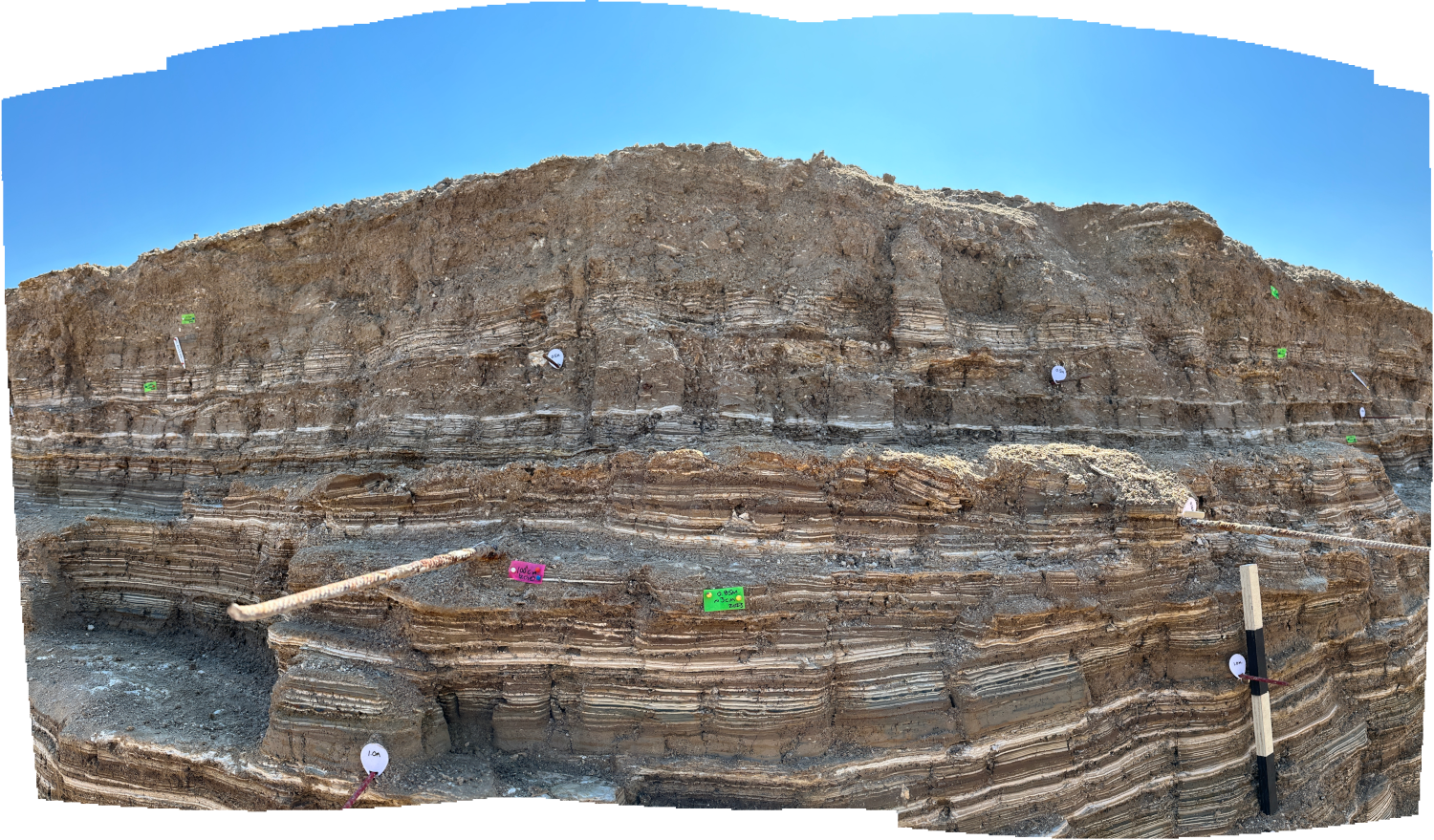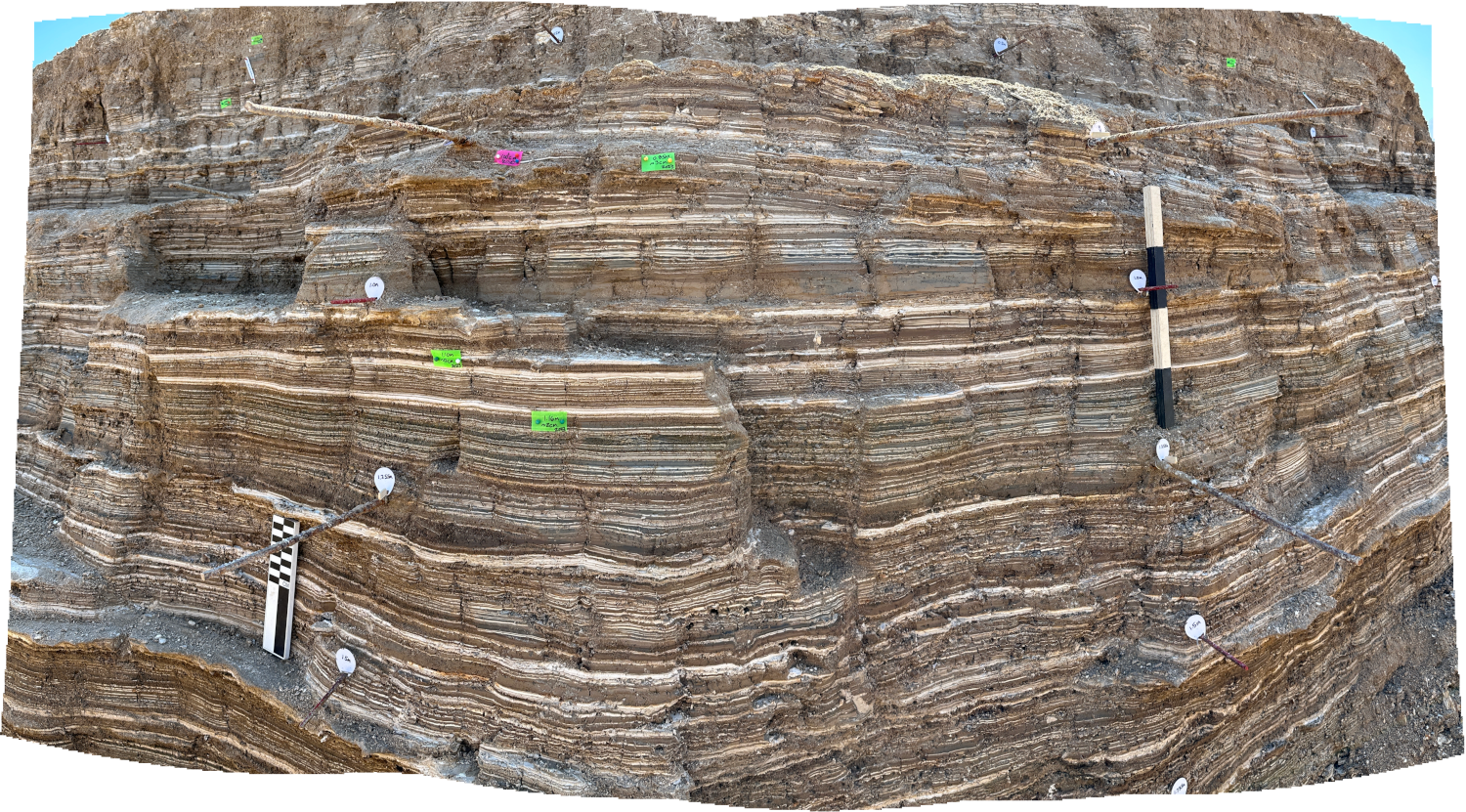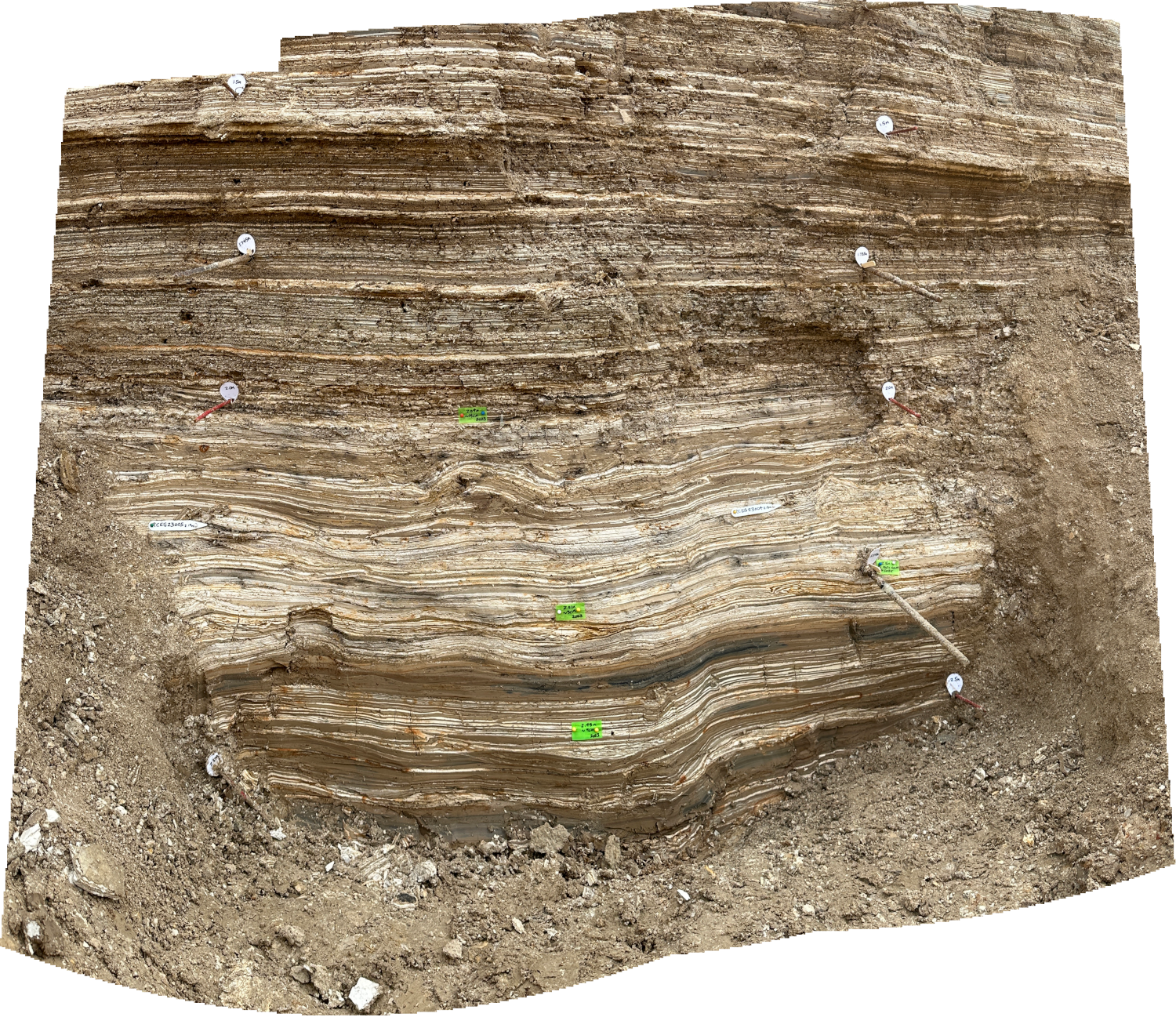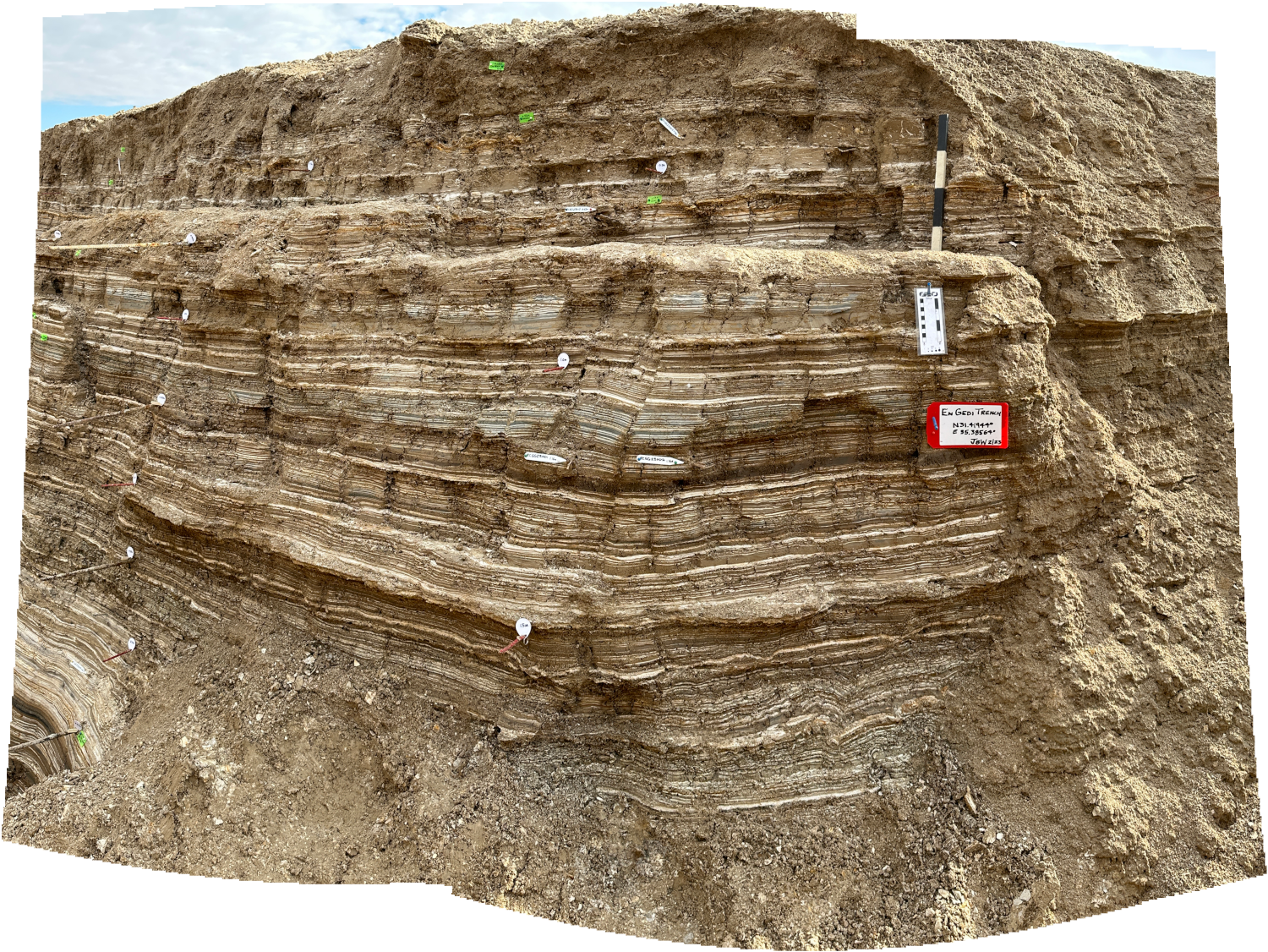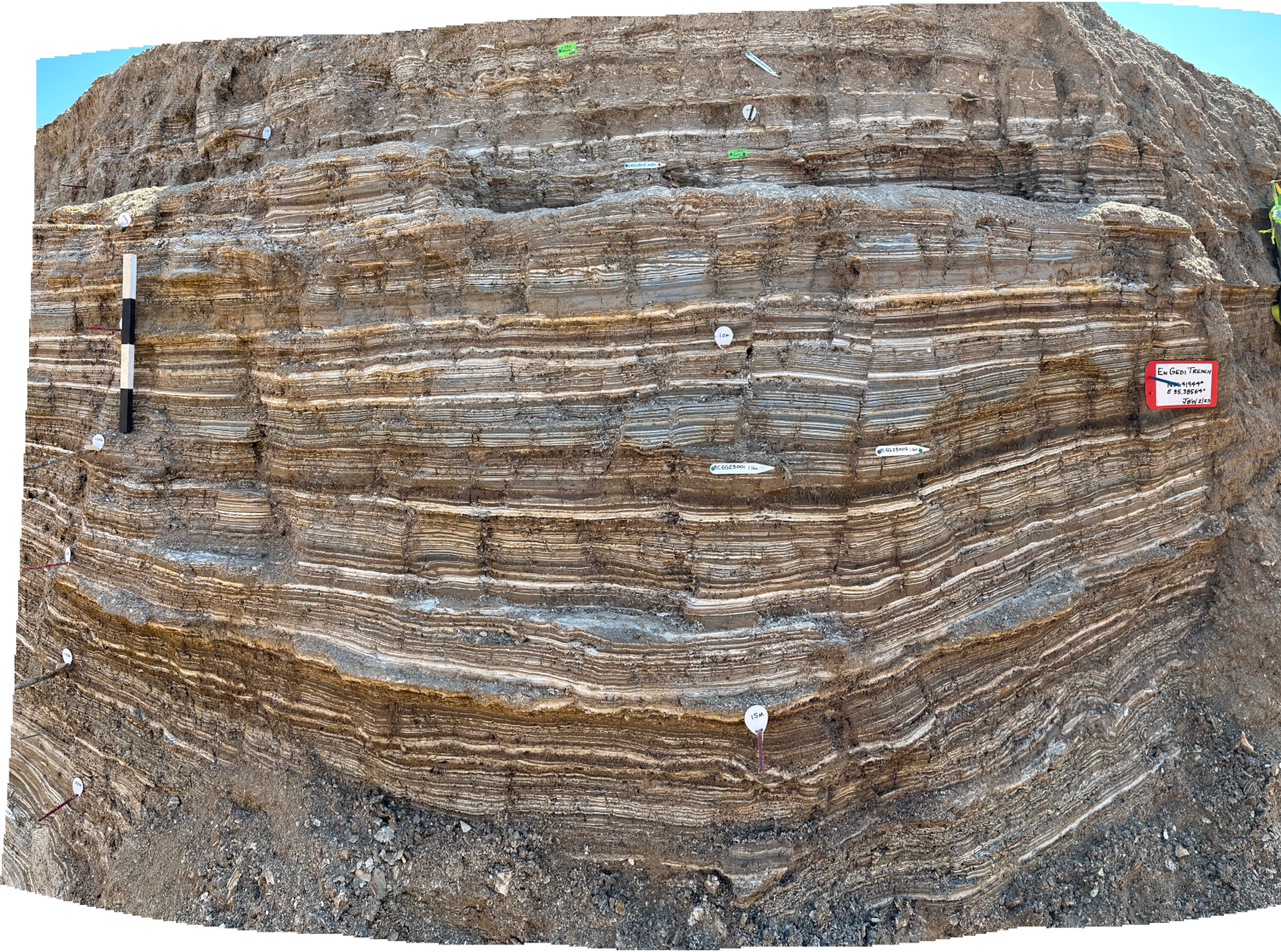En Gedi
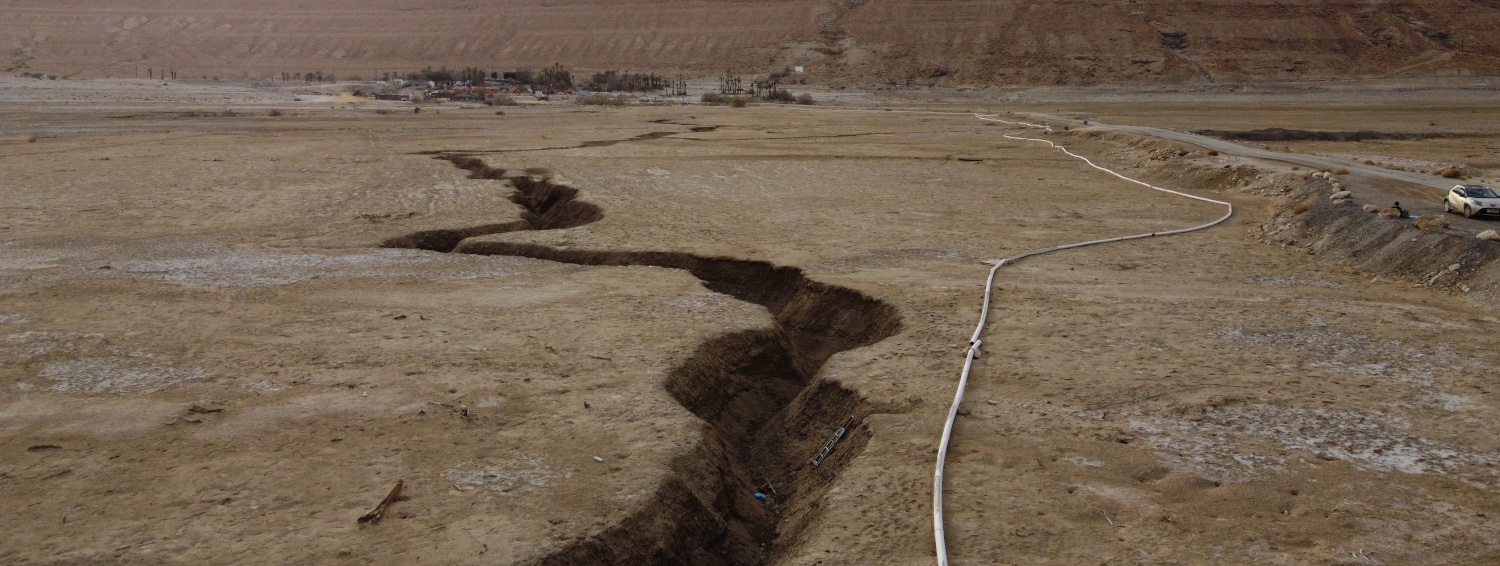 Aerial shot of En Gedi Trench from the east
Aerial shot of En Gedi Trench from the eastClick on Image for high resolution magnifiable image
Drone Photo by Jefferson Williams 11 Feb. 2023
| Transliterated Name | Source | Name |
|---|---|---|
| En Gedi | ||
| Ein Gedi | Hebrew | עֵין גֶּדִי |
| Ein Gedi | Arabic | عين جدي |
- Locations of En Gedi Core and Trench in Google Earth
- Locations of En Gedi Core and Trench
- Add 0.25 m to indicated depths in sections to match with depths of previous surveys - e.g. 2015, 2018, and DSEn (the En Gedi Core)
| Description | Image | Source |
|---|---|---|
| Entire En Gedi Trench |
Photo by Jefferson Williams 17 Feb. 2023 |
Jefferson Williams |
| Entire En Gedi Trench - closer in |
Photo by Jefferson Williams 16 Feb. 2023 |
Jefferson Williams |
| Entire East Section of En Gedi Trench |
Photo by Jefferson Williams 17 Feb. 2023 |
Jefferson Williams |
| Entire West Section of En Gedi Trench |
Photo by Jefferson Williams 17 Feb. 2023 |
Jefferson Williams |
| Entire Middle Section of En Gedi Trench |
Photo by Jefferson Williams 17 Feb. 2023 |
Jefferson Williams |
| Top of Middle Section of En Gedi Trench |
Photo by Jefferson Williams 17 Feb. 2023 |
Jefferson Williams |
| Middle 01 of Middle Section of En Gedi Trench |
Photo by Jefferson Williams 17 Feb. 2023 |
Jefferson Williams |
| Middle 02 of Middle Section of En Gedi Trench |
Photo by Jefferson Williams 17 Feb. 2023 |
Jefferson Williams |
| Bottom of Middle Section (Long shot) of En Gedi Trench |
Photo by Jefferson Williams 17 Feb. 2023 |
Jefferson Williams |
| Bottom of Middle Section (Medium shot) of En Gedi Trench |
Photo by Jefferson Williams 17 Feb. 2023 |
Jefferson Williams |
| Bottom of Middle Section (closeup) of En Gedi Trench |
Photo by Jefferson Williams 17 Feb. 2023 |
Jefferson Williams |
- Click Scaniverse icon in lower left to open full screen lidar scan in a new tab
Core Depths were measured from surface. The core was taken about a meter above the Dead Sea level which was ~ -411 m in 1997.
In 2011, Jefferson Williams measured the elevation of the surface where the En Gedi Core (DSEn) was taken using his GPS. The recorded elevation was -411 m however GPS is
less accurate measuring elevation than it is for Lat. and Long. so this depth measurement should be considered approximate.
| Image | Description | Image | Description | Image | Description | Image | Description | |
|---|---|---|---|---|---|---|---|---|

 Composite Core
Composite CoreDepths 19-397 cm. Sections from top to bottom - C1, A2, A3, and A4 GFZ/GSI |
Composite Core Sections C1, A2, A3, A4 19-397 cm. |

 Litholog and Composite Core
Litholog and Composite CoreDepths 47-325 cm. Litholog from Migowski (2001) |
Litholog and Composite Core 47-325 cm. |

 Litholog of Entire Core
Litholog of Entire CoreDepths -30-1022 cm. (-0.3-10.22 m) Migowski (2001) |
Litholog Entire Core -30 cm.-1022 cm. |

 Litholog Legend
Litholog LegendMigowski (2001) |
Litholog Legend |
|

 Core DSEn
Core DSEnSection C1 19-114 cm. GFZ/GSI |
Section C1 19-114 cm. |

 Core DSEn
Core DSEnSection A2 114-196 cm. GFZ/GSI |
Section A2 114-196 cm. |

 Core DSEn
Core DSEnSection A3 200-296 cm. GFZ/GSI |
Section A3 200-296 cm. |

 Core DSEn
Core DSEnSection A4 300-397 cm. GFZ/GSI |
Section A4 300-397 cm. |
|

 Figure 9
Figure 9Photo of breccia layer from the Ein Gedi drill core that matches the historical earthquake of 1458 A.D. (Migowski et al., 2004). Agnon et al. (2006) |
1458 CE Quake 65-80 cm. |
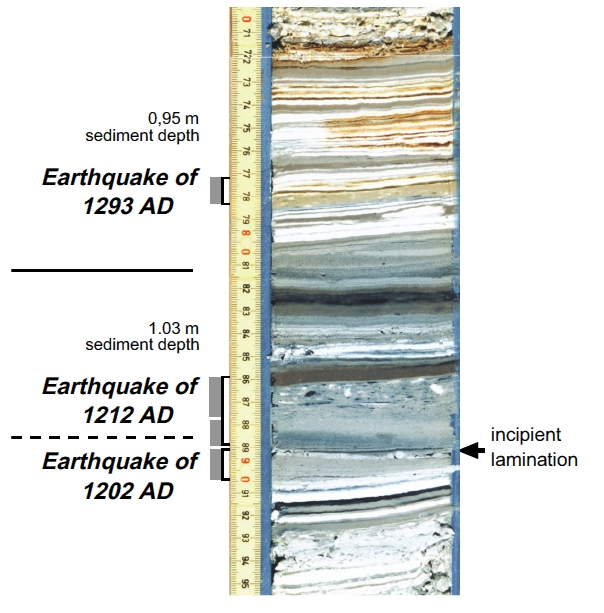
 Figure 10
Figure 10Photo of a section of the Ein Gedi core containing three breccia layers with the respective dates of earthquakes. The 1202 A.D. event is barely determined because the 1212 event almost obliterated the 10-yr-old breccia. Nonetheless, a few laminae (arrow) can be resolved above event horizon 1202 A.D. Migowski et al. (2004) have inferred five unresolved events by correlation of the lamina-counting record of breccia layers with the historical record of destructive earthquakes. Agnon et al. (2006) |
1202, 1212, and 1293 CE Quakes 90-115 cm. |
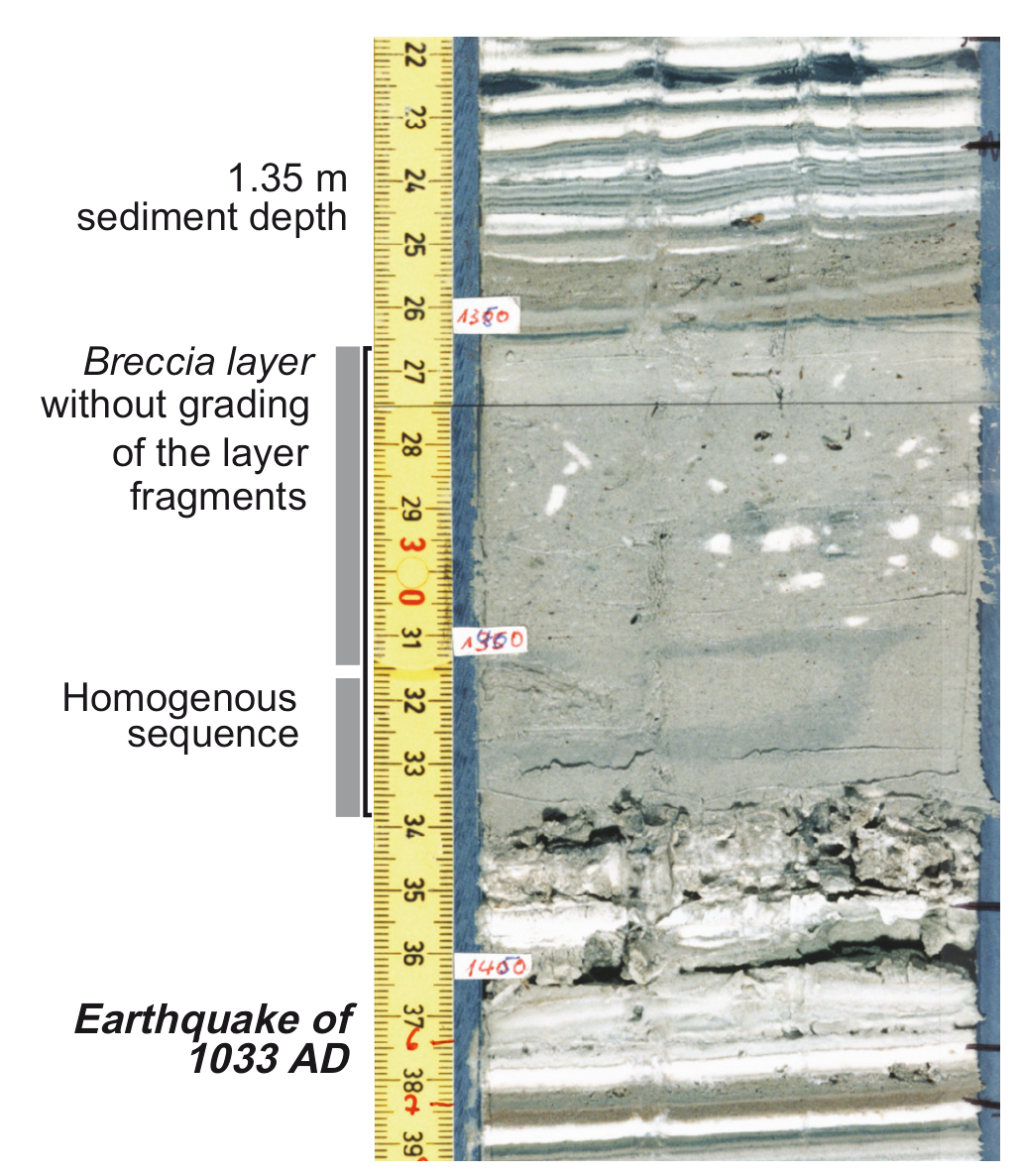
 Figure 9
Figure 9Photo of breccia layer from the Ein Gedi drill core that matches the historical earthquake of 1033 A.D. (Migowski et al., 2004). Agnon et al. (2006) |
1033 CE Quake 131-143 cm. |
|||

 Thin Section A3_3_1a
Thin Section A3_3_1aFlatbed Scan 259.7-269.9 cm. 2597-2699 mm. |
Thin Section A3_3_1a 259.7-269.9 cm. |

 Thin Section A3_3_2
Thin Section A3_3_22.5x Magnification Polarized 271.5-273.7 cm. 2715-2737 mm. |
Thin Section A3_3_2 271.5-273.7 cm. |

 Thin Section A3_3_3
Thin Section A3_3_32.5x Magnification Polarized 273.5-283.5 cm. 2735-2835 mm. |
Thin Section A3_3_3 273.5-283.5 cm. |

 Thin Section A3_4_1
Thin Section A3_4_1Flatbed Scan 283.3-293.4 cm. 2833-2934 mm. |
Thin Section A3_4_1 283.3-293.4 cm. |
|

 SEM Image
SEM Image250x Magnification Sample EG13 Very bottom of Dark Clastic layer above Jerusalem Quake 5-7 mm. Sample taken in En Gedi Trench by Jefferson Williams |
SEM Image 250x Magnification Sample EG13 from En Gedi Trench |
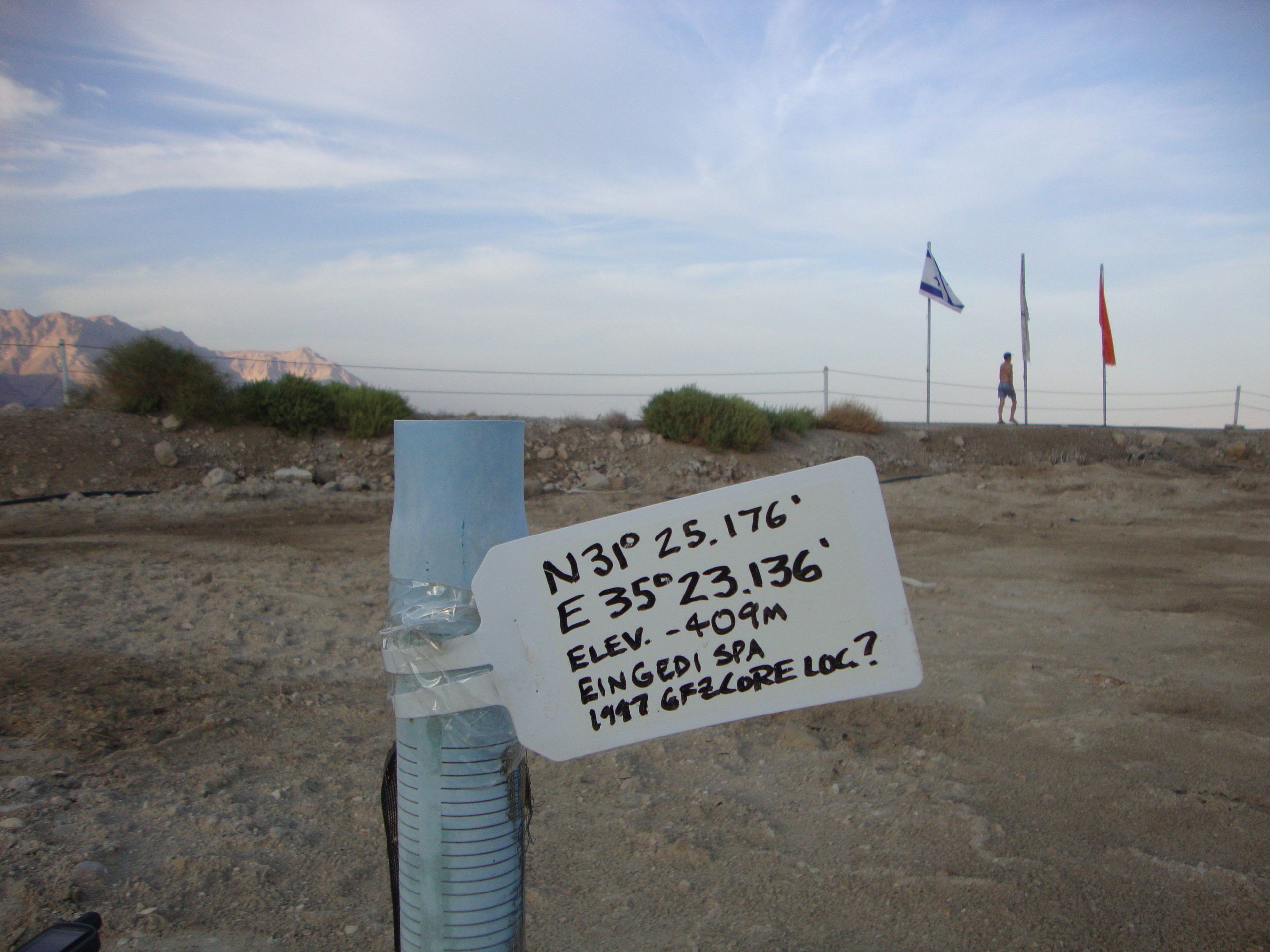
 Photo showing location of 1997 GFZ/GSI core at En Gedi Spa (DSEn)
Photo showing location of 1997 GFZ/GSI core at En Gedi Spa (DSEn)Photo taken by Jefferson Williams in 2010 |
Photo showing location of 1997 GFZ/GSI core at En Gedi Spa (DSEn) Lat = 31° 25.176' N Long = 35° 23.136' E Inaccurate Elevation |
- from Migowski et al (2004)
- these have been incorporated into the Master Seismic Events Table for the En Gedi Core (DSEn)
 Table 2a
Table 2aDeformed sequences of the Ein Gedi site and their correlation with earthquakes
Migowski et al (2004)
 Table 2b
Table 2bDeformed sequences of the Ein Gedi site and their correlation with earthquakes
Migowski et al (2004)
- from Kagan et al. (2011) Correction
- these have been incorporated into the Master Seismic Events Tables for all sites
 Table 4
Table 4Multisite Comparison of Holocene Seismites from four lacustrine sediments sites along the Western Dead Sea Basin
Kagan et al (2011)
 Table 4
Table 4Multisite Comparison of Holocene Seismites from four lacustrine sediments sites along the Western Dead Sea Basin
Kagan et al (2011)
- from Kagan et al. (2011)
- these have been incorporated into the Master Seismic Events Tables for all sites
 Table 4
Table 4Multisite Comparison of Holocene Seismites from four lacustrine sediments sites along the Western Dead Sea Basin
Kagan et al (2011)
- from Kagan et al. (2011)
 Figure 7
Figure 7Recurrence intervals and cumulative number of breccias in time.
- Ein Feshkha (EFE)
- Ein Gedi (EG)
- Zeelim (ZA1 and ZA2)
- Diamonds represent breccias
- circled diamonds are the IBS (intrabasin seismites)
- Horizontal gray bars indicate periods of seismic quiescence
(left) the earlier period is recorded at EG and ZA, and (right) the younger quiescence period is recorded at all three sites. Horizontal lines connect IBS events at the three sites.
Kagan et al (2011)
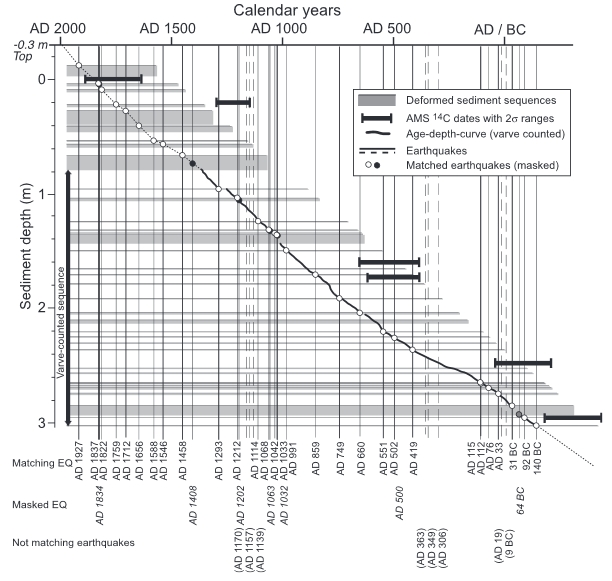 Figure 4
Figure 4The age-depth model of the Ein Gedi profile is derived from radiocarbon dating (black bars indicate 26 ranges) and varve-counting between 0.78 and 3.03 m. The floating annual chronology is anchored by a systematic comparison and correlation of deformed sediment sequences (grey bars) to a succession of historical strong earthquakes.
Migowski et al (2004)
- from Migowski (2001)
 Fig. 7.5
Fig. 7.5The age-depth model of the Ein Gedi profile is made possible by a shift of up to 350 years.
x-axis - Age [yrs cal BP]
y-axis - Sediment Depth [m]
German
Abb. 7.5
Das Alters-Tiefen-Modell des Ein Gedi-Profils wird durch die Zuordnung zu den Erdbeben um bis zu 350 Jahre verschoben.
Migowski (2001)
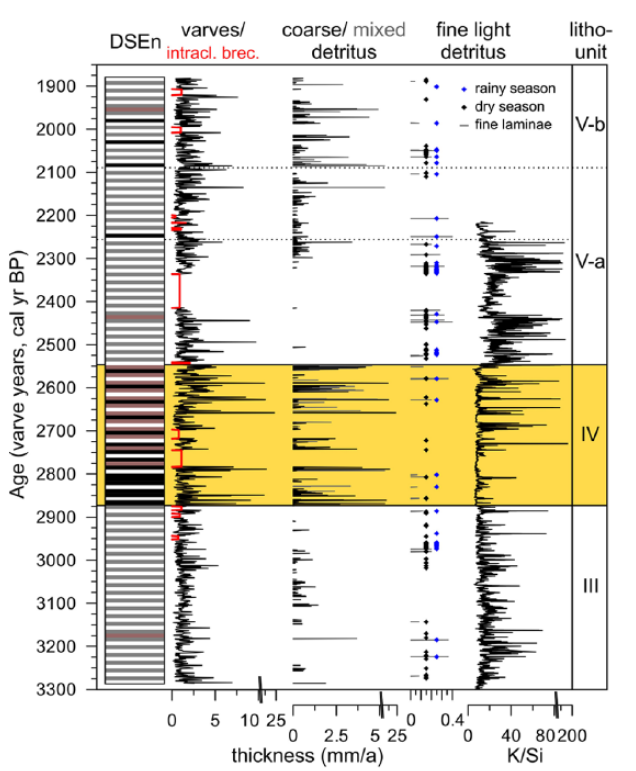 Figure 5
Figure 5Varve counting and thin section analysis results of core DSEn (2.10–4.35 m composite depth)
Tracks from left to right
varve thickness including intraclast breccias [in red] (‘seismites’, following Agnon et al., 2006)
thickness of coarse and mixed detrital layers; fine light detrital laminae thickness (grey bars) and cloudily distributed occurrences of the same material within aragonite laminae (dry season, black diamonds) and within common detrital layers (rainy season, blue diamonds)
K/Si ratio derived from µ-XRF
Lithological units correspond to those in Figure 4. For a legend of the core lithology, see Figure 2.
Neugebauer at al (2015)
 Figure 2
Figure 2DSEn and 5017-1 sediment profiles, magnetic susceptibility data (Mag. Sus.) and modelled 14C age–depth plots with 68.2% (dark grey; ~1σ error) and 95.4% (light grey; ~2σ error) confidence intervals
note that for 5017-1, the lowermost age included in the model (4673 ± 85 cal. yr BP at 32.36 m; Table 1) is not shown here for better readability of the figure
highlighted intervals
- ~3500–3300 cal. yr BP
- ~3000–2400 cal. yr BP
LU = lithological units (I–V) as in Figure 4.
Neugebauer at al (2015)
 Supplementary Figure S1
Supplementary Figure S1Correlation of cores DSEn and 5017-1 by radiocarbon ages, a marker layer (ML) and a characteristic succession of gypsum deposits.
Neugebauer at al (2015)

(a) Comparison of the Dead Sea data to other records
- difference in the total solar irradiance ΔTSI from the year 1986, 1365.57 W/m2 (Steinhilber et al., 2009)
- clay layer frequency record from the Black Sea (solid line - core GeoB7622, dashed line - core GeoB7625, thick line - 3-point moving average) - Lamy et al., 2006
- Dead Sea lake-level reconstruction based on core DSEn (dark blue line - Migowski et al. (2006), light blue line - this study
- Dead Sea K/Si ratio from µ-XRF element scanning (this study)
- Dead Sea coarse and mixed detrital layer thickness (this study)
- Soreq Cave δ18O speleothem record (Bar-Matthews et al., 2003) showing only very minor changes over the entire period investigated here
- Red Sea terrigeneous sand accumulation rate (core GeoB5804-1, thick line - 5-point moving average) - Lamy et al., 2006
- Red Sea stable oxygen isotope difference Δδ18O between planktic and epibenthic foraminifera (core GeoB5804-1, thick line - 5-point moving average) - Lamy et al., 2006
AO/NAO: Arctic Oscillation/North Atlantic Oscillation
4. and 5. from core DSEn and on radiocarbon-based age scale
(b) Inferred humidity changes in the eastern Mediterranean during the two dry periods at the Dead Sea, discussed here.
Neugebauer at al (2015)
 Fig. 2
Fig. 2Lithology of the sediment cores and the established age-depth models of the different profiles. The Ze'elim coring profile is paralleled by the Ze'elim gully wall [16] . The Ein Gedi chronology is based on 20 radiocarbon dates and on the varve counted section (black line) in the upper part.
Migowski et. al. 2004
 Figure 5
Figure 5Interpreted log of Ein Gedi core thin-section A3-3-2 (composite core depth 2715–2755 mm) and overlapping thin-section A3-3-3 (composite core depth 2737–2833 mm). As a result of thin-section microstratigraphy and varve quality determination, a composite varve chronology is shown in the central column.
Williams et. al. (2011)
 Figure 6
Figure 6Interpreted log of Ein Gedi core (for explanation see Figure 5)
Williams et. al. (2011)

 En Gedi Core -Section A3
En Gedi Core -Section A3GFZ/GSI
a year by year chronology from 140 BCE to 1458 CE

 Figure 4
Figure 4The age-depth model of the Ein Gedi profile is derived from radiocarbon dating (black bars indicate 26 ranges) and varve-counting between 0.78 and 3.03 m. The floating annual chronology is anchored by a systematic comparison and correlation of deformed sediment sequences (grey bars) to a succession of historical strong earthquakes.
Migowski et al. (2004)

 Fig. 7.5
Fig. 7.5(translated by Google & Williams)
The age-depth model of the Ein Gedi profile is made possible by a shift of up to 350 years.
x-axis - Age [yrs cal BP]
y-axis - Sediment Depth [m]
Migowski (2001)
Neugebauer (2015) and Neugebauer at al. (2015) recounted laminae from 2.1 - 4.35 meters in the En Gedi Core (DsEn) while also making a stratigraphic correlation to ICDP Core 5017-1. Nine 14C dates were used from 1.58 - 6.12 m but samples KIA9123 (inside the Late Bronze Beach Ridge) and KIA1160 (the 1st sample below the Late Bronze Beach Ridge) were discarded as outliers. These two samples gave dates approximately 400 years older than what was expected for the Late Bronze Age Beach Ridge


(a) Comparison of the Dead Sea data to other records
- difference in the total solar irradiance ΔTSI from the year 1986, 1365.57 W/m2 (Steinhilber et al., 2009)
- clay layer frequency record from the Black Sea (solid line - core GeoB7622, dashed line - core GeoB7625, thick line - 3-point moving average) - Lamy et al., 2006
- Dead Sea lake-level reconstruction based on core DSEn (dark blue line - Migowski et al. (2006), light blue line - this study
- Dead Sea K/Si ratio from µ-XRF element scanning (this study)
- Dead Sea coarse and mixed detrital layer thickness (this study)
- Soreq Cave δ18O speleothem record (Bar-Matthews et al., 2003) showing only very minor changes over the entire period investigated here
- Red Sea terrigeneous sand accumulation rate (core GeoB5804-1, thick line - 5-point moving average) - Lamy et al., 2006
- Red Sea stable oxygen isotope difference Δδ18O between planktic and epibenthic foraminifera (core GeoB5804-1, thick line - 5-point moving average) - Lamy et al., 2006
AO/NAO: Arctic Oscillation/North Atlantic Oscillation
4. and 5. from core DSEn and on radiocarbon-based age scale
(b) Inferred humidity changes in the eastern Mediterranean during the two dry periods at the Dead Sea, discussed here.
Click on image to open in a new tab
Neugebauer at al. (2015)
In the En Gedi core (DSEn), the Late Bronze Age Beach Ridge (Unit II of Neugebauer et al, 2015) is found from depths 4.35 to 4.55 m. It's top coincides with the bottom of the recounted interval - far away from the overlap (2.1 - 3.02 m) with Migowski's counted interval. Thus, if there were any problems with the recounted dates (e.g. hiatuses or accumulating systemic errors) as one moved to the top of the recounted interval, they would go unnoticed. Varve counts in the overlapped interval were fairly similar - 583 according to Migowski (2001) vs. 518 according to Neugebauer et al. (2015). There wasn't a major discrepancy in terms of varve count interpretation. But, the lack of a calibration point near the top of the recounted interval leaves one wondering if the recounted dates in the overlap are accurate and why Migowski's pre-shifted chronology doesn't correlate well with the reliable parts of the earthquake record.
Neugebauer at al. (2015:5) counted 1351 varves with an uncertainty of 7.5% (Neugebauer at al, 2015:8). That leads to an uncertainty of ~100 varves by the time one gets to the top of the recounted interval away from the Late Bronze Age Beach Ridge calibration point. The Beach Ridge itself likely has an uncertainty of +/- 75 years. Add the two together and the uncertainty approaches Migowski's shift. In addition, roughly 15% of the recounted interval went through intraclast breccias (seismites) where the varves were uncountable and the varve count was interpolated with a questionable multiplication factor of 1.61 applied to the interpolated varve count (Neugebauer at al, 2015:5). Migowski et al. (2004) also interpolated through the intraclast breccias however in her case she used the interpolation to line up with events out of the Earthquake catalogs.
Unfortunately, Neugebauer at al. (2015)'s study did not resolve the uncertainties associated with Migowski's varve counts. Both studies lack a sufficiently robust calibration over the entire depth interval. Dead Sea laminae are difficult to count. They are not nearly as "well-behaved" as they are in the older Lisan formation or in Glacial varves. This was illustrated by Lopez-Merino et al. (2016). Their study, which used seasonal palynology to ground truth varve counts, showed that between 1 and 5 laminae couplets (ie varves) could be deposited in a year


Section ZAII B4L - sampled about 1 meter below 31 BCE Josephus Quake seismite
Each bar represents one lamina. Lamina showing a preponderance of Autumnal pollen plots to the right; spring pollen to the left.
Asterisks (*) highlight the laminae in which it is possible that more than one detrital-aragonite couplet have been deposited in a year
Question marks (?) are anomalous results that may have suffered from contamination
paraphrasing and abridgment of original Figure description by JW
Lopez-Merino et al. (2016)
In 2018 and 2023, Jefferson Williams collected ~90 samples of dateable material from an erosional gully

 Erosional Gully at En Gedi
Erosional Gully at En Gediphoto by Jefferson Williams

 Location where En Gedi Core (DSEn) was taken in 1997 by GFZ/GSI
Location where En Gedi Core (DSEn) was taken in 1997 by GFZ/GSIphoto by Jefferson Williams

 Photo of coring operations in En Gedi in 1997
Photo of coring operations in En Gedi in 1997GFZ
| Description | Flight Date | Pilot | Processing | Downloadable Link |
|---|---|---|---|---|
| En Gedi Trench (includes location of 1997 GSI GFZ Core) |
11 Feb. 2023 | Jefferson Williams | ODM - no GCPs | Right Click to download. Then unzip |
| Description | Scan Date | Scanned with | Scanned by | Processing | Format | Downloadable Link |
|---|---|---|---|---|---|---|
| En Gedi Trench - Entire Section | 23 Feb. 2023 | iPhone 14 Pro | Jefferson Williams | Scaniverse - Photogrammetry | .las | Right Click to download |
| En Gedi Trench - Top East | 23 Feb. 2023 | iPhone 14 Pro | Jefferson Williams | Scaniverse - Photogrammetry | .las | Right Click to download |
| En Gedi Trench - Bottom East | 23 Feb. 2023 | iPhone 14 Pro | Jefferson Williams | Scaniverse - Photogrammetry | .las | Right Click to download |
| En Gedi Trench - Top of Middle | 23 Feb. 2023 | iPhone 14 Pro | Jefferson Williams | Scaniverse - Photogrammetry | .las | Right Click to download |
| En Gedi Trench - Bottom of Middle | 23 Feb. 2023 | iPhone 14 Pro | Jefferson Williams | Scaniverse - Photogrammetry | .las | Right Click to download |
| En Gedi Trench - Top of Bottom Middle | 23 Feb. 2023 | iPhone 14 Pro | Jefferson Williams | Scaniverse - Photogrammetry | .las | Right Click to download |
| En Gedi Trench - Middle of Bottom Middle | 23 Feb. 2023 | iPhone 14 Pro | Jefferson Williams | Scaniverse - Photogrammetry | .las | Right Click to download |
| En Gedi Trench - Bottom of Bottom Middle | 23 Feb. 2023 | iPhone 14 Pro | Jefferson Williams | Scaniverse - Photogrammetry | .las | Right Click to download |
| En Gedi Trench - Top West | 23 Feb. 2023 | iPhone 14 Pro | Jefferson Williams | Scaniverse - Photogrammetry | .las | Right Click to download |
| En Gedi Trench - Bottom West | 23 Feb. 2023 | iPhone 14 Pro | Jefferson Williams | Scaniverse - Photogrammetry | .las | Right Click to download |
Agnon, A., et al. (2006). "Intraclast breccias in laminated sequences reviewed: Recorders of paleo-earthquakes." Geological Society of America Special Papers 401: 195-214.
Kagan, E., et al. (2011). "Intrabasin paleoearthquake and quiescence correlation of the late Holocene Dead Sea." Journal of Geophysical Research 116(B4): B04311.
Kagan, E., et al. (2011). "Correction to “Intrabasin paleoearthquake and quiescence correlation of the late Holocene Dead Sea”." Journal of Geophysical Research: Solid Earth 116(B11): B11305.
Kagan, E. J. (2011). Multi Site Quaternary Paleoseismology Along the Dead Sea Rift: Independent Recording by Lake and Cave Sediments, PhD. Diss. Hebrew University of Jerusalem.
López-Merino, L., et al. (2016). "Using palynology to re-assess the Dead Sea laminated sediments – Indeed varves?" Quaternary Science Reviews 140: 49-66.
Migowski, C. (2001). Untersuchungen laminierter holozäner Sedimente aus dem Toten Meer: Rekonstruktionen von Paläoklima und -seismizität.
Migowski, C., et al. (2004).
"Recurrence pattern of Holocene earthquakes along the Dead Sea transform revealed by varve-counting and radiocarbon dating of
lacustrine sediments." Earth and Planetary Science Letters 222(1): 301-314.
Neugebauer, I., et al. (2014). "Lithology of the long sediment record recovered by the ICDP Dead Sea Deep Drilling Project (DSDDP)." Quaternary Science Reviews 102(0): 149-165.
Neugebauer, I., et al. (2015). "Evidences for centennial dry periods at ~3300 and ~2800 cal. yr BP from micro-facies analyses of the Dead Sea sediments." The Holocene.
Neugebauer, I. (2015). Reconstructing climate from the Dead Sea sediment record using high-resolution micro-facies analyses, Universität Potsdam. PhD.
Williams, J. B., et al. (2011). "An early first-century earthquake in the Dead Sea." International Geology Review 54(10): 1219-1228.



